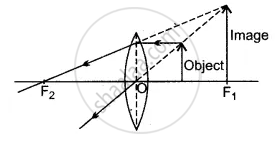Advertisements
Advertisements
Question
(i) Draw a ray diagram to show how the lens can be used as a ‘magnifying glass’? State the nature of the lens.
(ii) In what respect does the image in (i) above different from the image formed by a concave lens?
Solution
(i) The nature of the lens used is convex. The image formed is magnified, virtual, and upright. In this case, a convex lens is said to be used as a ‘magnifying glass.’

(ii) Image formed by a concave lens differs from the image in size. It is much smaller in size.
APPEARS IN
RELATED QUESTIONS
What is a magnifying glass?
The focal length of a convex lens is 25 cm. At what distance from the optical centre of the lens an object be placed to obtain a virtual image of twice the size?
An object is placed at a distance of 20 cm in front of a concave lens of focal length 20 cm. find: the magnification of image.
The magnification by a lens is -3. Name the lens and state how are u and v related?
The magnification by a lens is +0.5. Name the lens and state how are u and v related?
Why is the focal length of the lens, used as a magnifying glass, kept short?
What information we seek by the linear magnification of the image when it is positive or negative?
Name the lens for which magnification can be 1. For what position of the object will the magnification be 1?
Show with the help of a ray diagram, the path of the ray when incident normally on the first surface of the glass block, through the block and the liquid.
Write an expression for the magnifying power of a simple microscope. How can it be increased?
